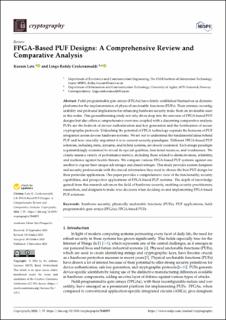| dc.contributor.author | Kusum, Lata | |
| dc.contributor.author | Cenkeramaddi, Linga Reddy | |
| dc.date.accessioned | 2023-11-13T11:32:30Z | |
| dc.date.available | 2023-11-13T11:32:30Z | |
| dc.date.created | 2023-11-07T10:22:06Z | |
| dc.date.issued | 2023 | |
| dc.identifier.citation | Lata. K. & Cenkeramaddi, L. R. (2023). FPGA-Based PUF Designs: A Comprehensive Review and Comparative Analysis. Cryptography. 7 (4), 55. | en_US |
| dc.identifier.issn | 2410-387X | |
| dc.identifier.uri | https://hdl.handle.net/11250/3102155 | |
| dc.description.abstract | Field-programmable gate arrays (FPGAs) have firmly established themselves as dynamic platforms for the implementation of physical unclonable functions (PUFs). Their intrinsic reconfigurability and profound implications for enhancing hardware security make them an invaluable asset in this realm. This groundbreaking study not only dives deep into the universe of FPGA-based PUF designs but also offers a comprehensive overview coupled with a discerning comparative analysis. PUFs are the bedrock of device authentication and key generation and the fortification of secure cryptographic protocols. Unleashing the potential of FPGA technology expands the horizons of PUF integration across diverse hardware systems. We set out to understand the fundamental ideas behind PUF and how crucially important it is to current security paradigms. Different FPGA-based PUF solutions, including static, dynamic, and hybrid systems, are closely examined. Each design paradigm is painstakingly examined to reveal its special qualities, functional nuances, and weaknesses. We closely assess a variety of performance metrics, including those related to distinctiveness, reliability, and resilience against hostile threats. We compare various FPGA-based PUF systems against one another to expose their unique advantages and disadvantages. This study provides system designers and security professionals with the crucial information they need to choose the best PUF design for their particular applications. Our paper provides a comprehensive view of the functionality, security capabilities, and prospective applications of FPGA-based PUF systems. The depth of knowledge gained from this research advances the field of hardware security, enabling security practitioners, researchers, and designers to make wise decisions when deciding on and implementing FPGA-based PUF solutions. | en_US |
| dc.language.iso | eng | en_US |
| dc.publisher | MDPI | en_US |
| dc.rights | Navngivelse 4.0 Internasjonal | * |
| dc.rights.uri | http://creativecommons.org/licenses/by/4.0/deed.no | * |
| dc.title | FPGA-Based PUF Designs: A Comprehensive Review and Comparative Analysis | en_US |
| dc.title.alternative | FPGA-Based PUF Designs: A Comprehensive Review and Comparative Analysis | en_US |
| dc.type | Peer reviewed | en_US |
| dc.type | Journal article | en_US |
| dc.description.version | publishedVersion | en_US |
| dc.rights.holder | © 2023 The Author(s) | en_US |
| dc.subject.nsi | VDP::Teknologi: 500 | en_US |
| dc.source.volume | 7 | en_US |
| dc.source.journal | Cryptography | en_US |
| dc.source.issue | 4 | en_US |
| dc.identifier.doi | https://doi.org/10.3390/cryptography7040055 | |
| dc.identifier.cristin | 2193060 | |
| dc.relation.project | Norges forskningsråd: 287918 | en_US |
| cristin.qualitycode | 1 | |

